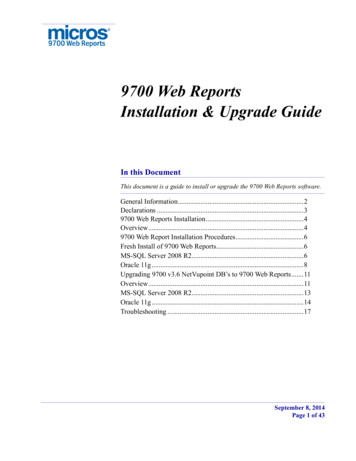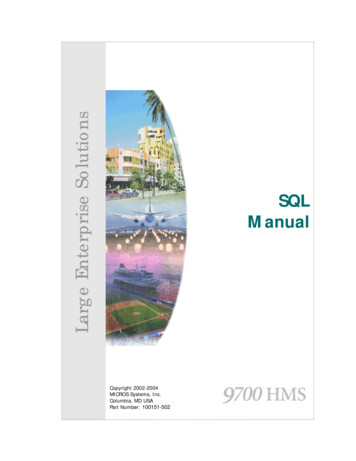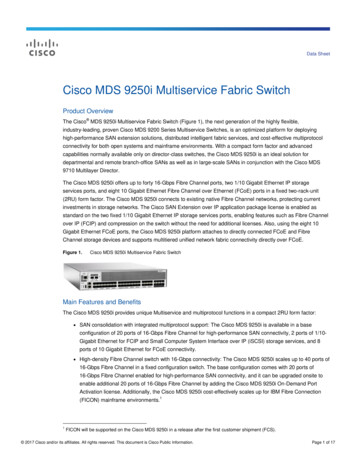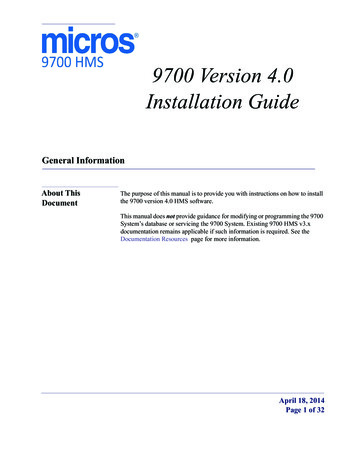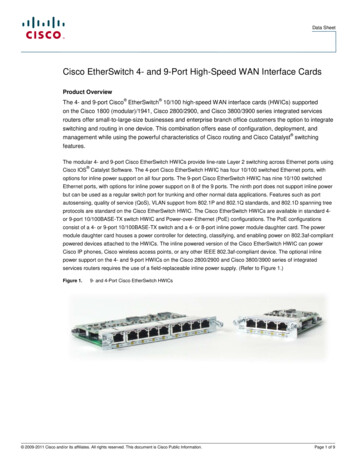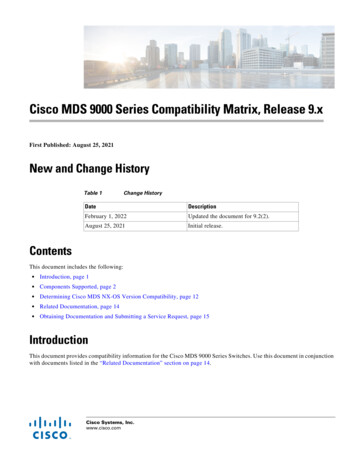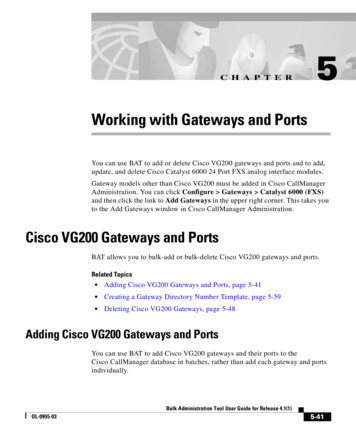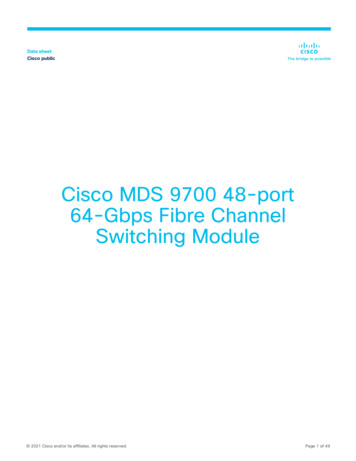
Transcription
Data sheetCisco publicDCisco MDS 9700 48-port64-Gbps Fibre ChannelSwitching Module 2021 Cisco and/or its affiliates. All rights reserved.Page 1 of 49
ContentsProduct overview3Main benefits4Product specification7Product sustainability47Ordering information47Cisco Capital49 2021 Cisco and/or its affiliates. All rights reserved.Page 2 of 49
The Cisco MDS 9700 48-Port 64-Gbps Fibre Channel Switching Module meets theperformance, availability, scalability, and efficiency needs of the most demandingmodern NVMe-based data centers.Product overviewThe Cisco MDS 9700 48-Port 64-Gbps Fibre Channel Switching Module (Figure 1) delivers predictableperformance, scalability, and innovative features to support modern data centers. The 64-Gbps 48-port FibreChannel switching module meets the high-performance needs for Non-Volatile Memory Express (NVMe) overFibre Channel and flash memory storage. It offers innovative services including full end-to-end NVMe support,onboard advanced Fibre Channel analytics engine, virtual machine awareness, Dynamic Rate Limiting Ingestion(DIRL), E-port and F-port diagnostics, integrated VSANs, Advanced Inter-VSAN Routing (IVR), and portchannels. It delivers full-duplex aggregate performance of 3072 Gbps, making it well suited for high-speed 64Gbps storage subsystems, 64-Gbps Inter-Switch Links (ISLs), high-performance virtualized servers, and NVMeand all-flash arrays.Figure 1.Cisco MDS 9700 48-Port 64-Gbps Fibre Channel Switching ModuleThe MDS 9700 48-Port 64-Gbps Fibre Channel Switching Module enables administrators to scale andconsolidate SAN deployments with fewer hardware components. Your SAN administrators can consolidateworkloads from hundreds of high-performance virtual machines and scale them with incremental updates asyour SAN grows while protecting your existing investment.This switching module ships with an advanced built-in analytics engine. The engine analyzes real-time FibreChannel exchanges and reports on various performance metrics in detail, enabling comprehensive and timelymonitoring of any potential performance problems among SAN edge devices. The onboard Network ProcessingUnit (NPU) in the module allows I/O-level metrics to be computed at every switch. The NPU can monitor allflows on all ports at line rates. In conjunction with the main processor, the NPU examines every exchangepassing through the 64-Gbps Application-Specific Integrated Circuit (ASIC) to capture flow metrics such asexchange completion time, maximum number of outstanding exchanges, data access latency, read and writeI/O Operations Per Second (IOPS), throughput, Logical Unit Number (LUN) access pattern (sequential orrandom), and I/O block sizes. 2021 Cisco and/or its affiliates. All rights reserved.Page 3 of 49
The 64G switching module is hot swappable and compatible with older 16- and 32-Gbps Fibre Channelmodules (all previously sold modules on Cisco MDS 9700 Director can work simultaneously with the newmodule). The 64G module supports hot-swappable Enhanced Small Form-Factor Pluggable (SFP )transceivers. Individual ports can be configured with Cisco 64-, 32-, and 16-Gbps SFP transceivers. Eachport on the new 64G switching module can autonegotiate port speed to 64-, 32-, 16- or 8-Gbps. Each portsupports 1000 buffer credits for exceptional extensibility without the need for additional licenses. With theCisco MDS 9000 Family Enterprise Package, up to 16,000 buffer credits can be allocated to an individual port,enabling full link bandwidth over long distances with no degradation in link utilization.The 64-Gbps Fibre Channel switching module also provides existing features such as predictable performance,high availability, advanced traffic management capabilities, integrated VSAN and IVR, resilient highperformance ISLs, hardware-assisted slow-drain support, comprehensive security frameworks, fault detectionand isolation of errored packets, and sophisticated diagnostics.Main benefitsThe Cisco MDS 9700 48-Port 64-Gbps Fibre Channel Switching Module offers the following benefits: Lower Total Cost of Ownership (TCO) with SAN consolidation: With the exponential growth of data intoday’s business environment, organizations need to deploy large-scale SANs in the most efficient andcost-effective ways. To meet scalability requirements while managing TCO, the MDS 9700 Seriesdirectors offer the following: Industry-leading port density of up to 768 line-rate 64-Gbps Fibre Channel ports per Cisco MDS9718 chassis 3-Tbps Fibre Channel nonblocking and non-oversubscribed I/O per slot Up to 48-Tbps front-panel Fibre Channel line-rate nonblocking and non-oversubscribed system-levelswitching Built-in network processing unit for advanced inline analytics Ability to reuse currently supported Cisco 16- and 32-Gbps SFP optics Exceptional capabilities with intelligent fabric services; for example, VSAN, IVR, QoS, etc. VSANs for consolidating individual physical SAN islands while maintaining logical boundaries IVR for sharing resources across VSANs Enterprise-ready features to enable the consolidation of an organization’s data assets into fewer,larger, and more manageable SANs, thus reducing the hardware footprint and associated capital andoperating expenses; for example, enhanced zoning in MDS, Cisco Smart Zoning, enhanced devicealias, etc. End-to-end NVMe support with analytics: All currently shipping Cisco products support the latest NVMeover Fibre Channel (FC) protocols. In addition to supporting NVMe over FC traffic, the built-in analyticsengine also collects real-time performance data that supports the data center workloads’ highperformance requirements. 2021 Cisco and/or its affiliates. All rights reserved.Page 4 of 49
Enterprise-class availability: The Cisco MDS 9700 Series Multilayer Director was specifically designedfrom the beginning for high-availability and mission-critical environments. Beyond meeting the basicrequirements of nondisruptive software upgrades and redundancy of all critical hardware components,the MDS 9700 Series software architecture offers outstanding greater than five-nines availability. Virtual machine–aware SAN deployment: Cisco SAN Analytics available on the MDS switches nativelyprovides end-to-end visibility into Virtual Machine-Initiator-Target-LUN (VM-ITL) flow for SCSIoperations or Virtual Machine-Initiator-Target-Namespace (VM-ITN) flow for NVMe operations. Also,Cisco Data Center Network Manager (DCNM) provides end-to-end visibility from virtual machines tostorage devices. Resource allocation, performance measurements, and predictions are available on aper-virtual machine basis to enable rapid troubleshooting in mission-critical virtualized environments. Advanced traffic management: The following advanced traffic management capabilities, integrated intoevery MDS 9700 48-Port 64-Gbps Fibre Channel Switching Module, simplify deployment andoptimization of large-scale fabrics: The Virtual Output Queue (VOQ) helps ensure line-rate performance on each port, independent oftraffic pattern, by eliminating head-of-line blocking. Up to 16,000 buffer-to-buffer credits can be assigned to any individual port for optimal bandwidthutilization across distances. Port channels allow up to 16 physical ISLs to be aggregated into a single logical bundle, providingoptimized bandwidth utilization across all links. The bundle can be a mix of any port from any modulein the chassis. This approach helps ensures that the bundle can remain active even if a module fails. Fabric Shortest Path First (FSPF)–based multipathing provides the intelligence to load balance acrossup to 16 equal-cost paths and dynamically reroute traffic if a switch fails. QoS helps manage bandwidth and control latency to prioritize critical traffic and is available on everyport. The lossless network-wide in-order delivery guarantee helps ensure that frames are never reorderedwithin a switch. This guarantee extends across the entire multiswitch fabric where the fabric is stableand no topology changes have been made. Cisco Dynamic Ingress Rate Limiting (DIRL): MDS 9700 48-Port 64-Gbps Fibre Channel SwitchingModule supports the new feature of dynamic ingress rate limiting. Using DIRL, the MDS SAN canautomatically detect any symptoms of congestion and then dynamically rate limits the congested andslow-drain devices so that adverse effects are not spread to other devices. DIRL dynamically adapts therate-limiting to suit the traffic profile of the congestion or slow-drain device. 2021 Cisco and/or its affiliates. All rights reserved.Page 5 of 49
Advanced diagnostics and troubleshooting tools: The MDS 9700 Series integrates proactive diagnostics,tools to verify connectivity and route latency and to capture and analyze traffic, thereby simplifying themanagement of large-scale storage networks. The Power-On Self-Test (POST) and online diagnosticsprovide proactive health monitoring. The powerful Cisco Generic Online Diagnostics (GOLD) frameworkis a suite of diagnostic facilities that verify whether the hardware and internal data paths are operating asdesigned. Boot-time diagnostics, continuous monitoring, standby fabric loopback tests, and on-demandand scheduled tests are part of the GOLD feature set. This industry-leading diagnostics subsystemenables rapid fault isolation and continuous system monitoring, which are critical features in today'scontinuously operating environments.Integrated hardware functions support diagnostic capabilities such as Fibre Channel traceroute toidentify the exact path and timing of flows, and Cisco Switched Port Analyzer (SPAN) and Remote SPAN(RSPAN) to intelligently capture network traffic. The captured Fibre Channel traffic can be analyzed usingCisco Fabric Analyzer software. Comprehensive port-based and flow-based statistics enablesophisticated performance analysis and Service-Level Agreement (SLA) accounting. Comprehensive solution for robust security: Addressing the need for stringent security in storagenetworks, the MDS 9700 Series 64-Gbps Fibre Channel line card offers an extensive security frameworkto protect the highly sensitive data crossing today’s enterprise networks. The MDS 9700 Series employsintelligent packet inspection at the port level, including the application of ACLs for hardware enforcementof zones, VSANs, and advanced port security features. VSANs are used to achieve greater security andstability by providing complete isolation of devices that are connected to the same physical SAN. IVRenables controlled sharing of resources between VSANs.In addition, FC-SP1 provides switch-to-switch and host-to-switch Diffie-Hellman Challenge HandshakeAuthentication Protocol (DH‑CHAP) authentication supporting RADIUS or TACACS to help ensure thatonly authorized devices access protected storage networks. Cisco TrustSec1Fibre Channel linkencryption, available on the MDS 9700 Series 64-Gbps modules, allows you to transparently encryptISLs at up to line-rate speeds, providing an additional layer of protection for traffic within and betweendata centers. The MDS 9700 Series supports a fabric binding feature that helps ensure that ISLs areenabled only between specified switches in the fabric binding configuration. 1Integrated mainframe support:1 The MDS 9700 Series is mainframe ready, with full support for IBMSystem Z Fibre Connection (FICON) and Linux environments. The MDS 9700 Series supports transport ofthe FICON protocol in both cascaded and noncascaded fabrics. It also supports a mix of FICON andopen-systems Fibre Channel Protocol (FCP) traffic on the same switch.Mainframe support available in the future release of Cisco NX-OS after Release 9.2.1. 2021 Cisco and/or its affiliates. All rights reserved.Page 6 of 49
Product specificationTable 1 lists the product technical specifications for the Cisco MDS 9700 48-Port 32-Gbps Fibre ChannelSwitching Modules.Table 1.Technical specificationsFeatureDescriptionProduct compatibilityCisco MDS 9700 Series Multilayer DirectorsSoftware compatibilityCisco MDS 9000 NX-OS Software Release NX-OS 9.2(1)Protocols Fibre Channel standards FC-PI-6 (INCITS 512-2015) FC-PI-7 (INCITS 543-2019) FC-FS-4 (INCITS 488-2016) FC-FS-5 (INCITS 545-2019) FC-GS-7 (INCITS 510-2017) FC-GS-8 (INCITS 548-2020) FC-LS-3 (INCITS 487-2018) FC-LS-4 (INCITS 553-2020) FC-SW-6 (INCITS 511-2016) FC-SW-7 (INCITS 547-2020) FC-NVMe (INCITS 540-2018) FC-NVMe-2 (INCITS 556-2020) FC-PH, Revision 4.3 (ANSI INCITS 230-1994) FC-PH, Amendment 1 (ANSI INCITS 230-1994/AM1-1996) FC-PH, Amendment 2 (ANSI INCITS 230-1994/AM2-1999) FC-PH-2, Revision 7.4 (ANSI INCITS 297-1997) FC-PH-3, Revision 9.4 (ANSI INCITS 303-1998) FC-PI, Revision 13 (ANSI INCITS 352-2002) FC-PI-2, Revision 10 (ANSI INCITS 404-2006) FC-PI-3, Revision 4 (ANSI INCITS 460-2011) FC-PI-4, Revision 8 (ANSI INCITS 450-2008) FC-PI-5, Revision 6 (ANSI INCITS 479-2011) FC-FS, Revision 1.9 (ANSI INCITS 373-2003) FC-FS-2, Revision 1.01 (ANSI INCITS 424-2007) FC-FS-2, Amendment 1 (ANSI INCITS 424-2007/AM1-2007) FC-FS-3, Revision 1.11 (ANSI INCITS 470-2011) FC-LS, Revision 1.62 (ANSI INCITS 433-2007) FC-LS-2, Revision 2.21 (ANSI INCITS 477-2011) FC-SW-2, Revision 5.3 (ANSI INCITS 355-2001) FC-SW-3, Revision 6.6 (ANSI INCITS 384-2004) FC-SW-4, Revision 7.5 (ANSI INCITS 418-2006) FC-SW-5, Revision 8.5 (ANSI INCITS 461-2010) FC-GS-3, Revision 7.01 (ANSI INCITS 348-2001) FC-GS-4, Revision 7.91 (ANSI INCITS 387-2004) 2021 Cisco and/or its affiliates. All rights reserved.Page 7 of 49
FC-GS-5, Revision 8.51 (ANSI INCITS 427-2007) FC-GS-6, Revision 9.4 (ANSI INCITS 463-2010) FCP, Revision 12 (ANSI INCITS 269-1996) FCP-2, Revision 8 (ANSI INCITS 350-2003) FCP-3, Revision 4 (ANSI INCITS 416-2006) FCP-4, Revision 2b (ANSI INCITS 481-2011) FC-SB-2, Revision 2.1 (ANSI INCITS 349-2001) FC-SB-3, Revision 1.6 (ANSI INCITS 374-2003) FC-SB-3, Amendment 1 (ANSI INCITS 374-2003/AM1-2007) FC-SB-4, Revision 3.0 (ANSI INCITS 466-2011) FC-SB-5, Revision 2.00 (ANSI INCITS 485-2014) FC-BB-6, Revision 2.00 (ANSI INCITS 509-2014) FC-BB-2, Revision 6.0 (ANSI INCITS 372-2003) FC-BB-3, Revision 6.8 (ANSI INCITS 414-2006) FC-BB-4, Revision 2.7 (ANSI INCITS 419-2008) FC-BB-5, Revision 2.0 (ANSI INCITS 462-2010) FC-VI, Revision 1.84 (ANSI INCITS 357-2002) FC-SP, Revision 1.8 (ANSI INCITS 426-2007) FC-SP-2, Revision 2.71 (ANSI INCITS 496-2012) FAIS, Revision 1.03 (ANSI INCITS 432-2007) FAIS-2, Revision 2.23 (ANSI INCITS 449-2008) FC-IFR, Revision 1.06 (ANSI INCITS 475-2011) FC-FLA, Revision 2.7 (INCITS TR-20-1998) FC-PLDA, Revision 2.1 (INCITS TR-19-1998) FC-Tape, Revision 1.17 (INCITS TR-24-1999) FC-MI, Revision 1.92 (INCITS TR-30-2002) FC-MI-2, Revision 2.6 (INCITS TR-39-2005) FC-MI-3, Revision 1.03 (INCITS TR-48-2012) FC-DA, Revision 3.1 (INCITS TR-36-2004) FC-DA-2, Revision 1.06 (INCITS TR-49-2012) FC-MSQS, Revision 3.2 (INCITS TR-46-2011) Fibre Channel classes of service: Class 2, Class 3, and Class F Fibre Channel standard port types: E, F, FL, and B Fibre Channel enhanced port types: SD, ST, and TECards, ports, and slots 48 autosensing 8/16/32/64-Gbps Fibre Channel ports Can be used on any payload slot of the MDS 9700 Series directors Can coexist with the MDS 9700 16-Gbps Fibre Channel module and the 32-Gbps FibreChannel module without any restrictions on the location and the number of modules 2021 Cisco and/or its affiliates. All rights reserved.Page 8 of 49
Features and functionsFabric services Name server Registered State-Change Notification (RSCN) Login services Fabric Configuration Server (FCS) Broadcast In-order delivery Congestion management with FPINAdvanced functions VSAN IVR Port channel with multipath load balancing Flow-based and zone-based QoS N-Port ID Virtualization (NPIV) Inline analyticsDiagnostics and troubleshootingtools POST diagnostics Online diagnostics Internal port loopbacks SPAN and RSPAN Fibre Channel traceroute Fibre Channel ping Fibre Channel debug Cisco Fabric Analyzer Syslog Online system health Port-level statistics Real-time protocol debug E-port and F-port diagnostics 2021 Cisco and/or its affiliates. All rights reserved.Page 9 of 49
Network security VSANs ACLs Per-VSAN RBAC Fibre Channel zoning N-port Worldwide Name (WWN) N-port Fibre Channel ID (FC-ID) Fx-port WWN Fx-port WWN and interface index Fx-port domain ID and interface index Fx-port domain ID and port number FC-SP1 DH-CHAP switch-to-switch authentication DH-CHAP host-to-switch authentication Port security and fabric binding Management access SSHv2 implementing AES SNMPv3 implementing AES SFTP Cisco TrustSec Fibre Channel link-level encryption SSHv2 implementing AESServiceability Configuration file management Nondisruptive software upgrades for Fibre Channel interfaces Cisco Call Home Power-management LEDs Port beaconing System LED SNMP traps for alerts Network bootPerformance Port speed: 8/16-Gbps, 8/16/32-Gbps, and 8/16/32/64-Gbps autosensing Fibre Channel Buffer credits: Default credits per port: 1000 With Enterprise license 24,000 shared among a single port group of 16 ports 16,000 maximum credits per port Port channel: up to 16 ports 2021 Cisco and/or its affiliates. All rights reserved.Page 10 of 49
Supported Cisco optics, media,and transmission distancesSpeedMedia 32-Gbps shortwave LC, SFP 9/125-micron single mode 32-Gbps longwave, LC, SFP 50/125-micron multimode 16-Gbps shortwave, LC, 9/125-micron single modeSFP 16-Gbps longwave, LC, SFP 50/125-micron multimodeDistance 70m OM3 and 100mOM4. 10 km 100m OM3 and 125mOM4 10 km 150m OM3 and 190mOM4 10 kmReliability and availability Hot-swappable module Hot-swappable SFP transceivers Online diagnostics Stateful process restart Nondisruptive supervisor failover Any-module, any-port configuration for port channels Fabric-based multipathing Per-VSAN fabric services Port tracking Virtual Routing Redundancy Protocol (VRRP) for managementNetwork management Access methods through MDS 9700 Series Supervisor-4 Module Out-of-band 10/100/1000 Ethernet port (Supervisor-4) RS-232 serial console port In-band IP over Fibre Channel Access protocols Command-Line Interface (CLI) through console and Ethernet ports SNMPv3 through Ethernet port and in-band IP over Fibre Channel access Distributed Device Alias service Network security Per-VSAN RBAC using RADIUS- and TACACS -based Authentication, Authorization, andAccounting (AAA) functions SFTP SSHv2 implementing AES SNMPv3 implementing AES Management applications Cisco MDS 9000 Family CLI Cisco DCNM Cisco Device Manager Dynamic Ingestion Rate Limiting (DIRL) FPIN-based ingestion notification Patented technology to intelligently manage traffic Improve traffic consistency in performance 2021 Cisco and/or its affiliates. All rights reserved.Page 11 of 49
Programming interfaces Scriptable CLI Cisco Prime DCNM web services API Cisco Prime DCNM GUI Representational State Transfer (REST) API NX-API On-switch Python AnsibleSAN Analytics In-line and non-disruptive visibility into at least 40,000 flows per MDS 9700 director and atleast 20,000 flows per module Collect at least 70 metrics per flow Granularity of Virtual Machine-Initiator-Target-LUN (VM-ITL) flow for SCSI operations orVirtual Machine-Initiator-Target-Namespace (VM-ITN) flow for NVMe operations Real-time visibility in microseconds SAN Analytics is available on host ports, storage ports, and ISL ports. Export SAN Analytics metrics directly from the MDS switches in an open format for easythird-party integrationCongestion detection andprevention Slow drain (Tx B2B credit starvation) detection at 2.5 microseconds granularity Congestion due to over-utilization detection at 10 seconds granularity Microburst detection multiple times in 10 seconds duration Congestion prevention by dynamically rate limiting the congested devices using DIRL feature Automatic congestion isolation and de-isolation of congested devices to a dedicated virtuallink Congestion recovery by dropping traffic to congestion device using no-credit-drop timeoutand congestion-drop timeout Timestamped logging of congestion events for easy troubleshooting Fabric-wide DCNM slow-drain analysis for single-pane of glass visibility across the entireMDS SAN fabricEnvironmental Temperature, ambient operating: 32 to 104 F (0 to 40 C) Temperature, ambient nonoperating and storage: –40 to 158 F (–40 to 70 C) Relative humidity, ambient (noncondensing) operating: 10% to 90% Relative humidity, ambient (noncondensing) nonoperating and storage: 10% to 95% Altitude, operating: –197 to 6500 ft (–60 to 2000m)Physical dimensions Dimensions (H x W x D): 1.75 x 15.9 x 21.8 in. (4.4 x 40.39 x 55.37 cm) Weight: 17.5 lb (7.94 kg) 2021 Cisco and/or its affiliates. All rights reserved.Page 12 of 49
Approvalsand complianceFeature Regulatory complianceDescriptionProduct compatibilityCiscoMDS9700 Series Multilayer Directors SafetycomplianceSoftware compatibilityCisco MDS 9000 NX-OS Software Release NX-OS 9.2(1) CE Markings per directives 2004/108/EC and 2006/95/ECProtocols UL 60950-1 Second Edition CAN/CSA-C22.2 No. 60950-1 Second EditionENChannel60950-1standardsSecond Edition Fibre IEC60950-1SecondEditionFC-PI-6(INCITS512-2015) AS/NZSFC-PI-7 60950-1(INCITS 543-2019) GB4943FC-FS-42001(INCITS 488-2016) EMCcompliance FC-FS-5(INCITS 545-2019) 47CFRPart15 (CFR47) Class AFC-GS-7(INCITS510-2017) AS/NZSAFC-GS-8CISPR22(INCITS Class548-2020) CISPR22A 487-2018)FC-LS-3 Class(INCITS EN55022Class A 553-2020)FC-LS-4 (INCITS ICES003A 511-2016)FC-SW-6Class(INCITS VCCIClass(INCITSAFC-SW-7547-2020) EN61000-3-2FC-NVMe (INCITS 540-2018) EN61000-3-3 FC-NVMe-2 (INCITS 556-2020) ClassA KN22FC-PH,Revision4.3 (ANSI INCITS 230-1994) Class A 1 (ANSI INCITS 230-1994/AM1-1996) CNS13438FC-PH, Amendment EN55024FC-PH, Amendment 2 (ANSI INCITS 230-1994/AM2-1999) CISPR24FC-PH-2, Revision 7.4 (ANSI INCITS 297-1997) EN300386FC-PH-3, Revision 9.4 (ANSI INCITS 303-1998) KN24 2021 Cisco and/or its affiliates. All rights reserved.Page 13 of 49
FC-PI, Revision 13 (ANSI INCITS 352-2002) FC-PI-2, Revision 10 (ANSI INCITS 404-2006) FC-PI-3, Revision 4 (ANSI INCITS 460-2011) FC-PI-4, Revision 8 (ANSI INCITS 450-2008) FC-PI-5, Revision 6 (ANSI INCITS 479-2011) FC-FS, Revision 1.9 (ANSI INCITS 373-2003) FC-FS-2, Revision 1.01 (ANSI INCITS 424-2007) FC-FS-2, Amendment 1 (ANSI INCITS 424-2007/AM1-2007) FC-FS-3, Revision 1.11 (ANSI INCITS 470-2011) FC-LS, Revision 1.62 (ANSI INCITS 433-2007) FC-LS-2, Revision 2.21 (ANSI INCITS 477-2011) FC-SW-2, Revision 5.3 (ANSI INCITS 355-2001) FC-SW-3, Revision 6.6 (ANSI INCITS 384-2004) FC-SW-4, Revision 7.5 (ANSI INCITS 418-2006) FC-SW-5, Revision 8.5 (ANSI INCITS 461-2010) FC-GS-3, Revision 7.01 (ANSI INCITS 348-2001) FC-GS-4, Revision 7.91 (ANSI INCITS 387-2004) FC-GS-5, Revision 8.51 (ANSI INCITS 427-2007) FC-GS-6, Revision 9.4 (ANSI INCITS 463-2010) FCP, Revision 12 (ANSI INCITS 269-1996) FCP-2, Revision 8 (ANSI INCITS 350-2003) FCP-3, Revision 4 (ANSI INCITS 416-2006) FCP-4, Revision 2b (ANSI INCITS 481-2011) FC-SB-2, Revision 2.1 (ANSI INCITS 349-2001) FC-SB-3, Revision 1.6 (ANSI INCITS 374-2003) FC-SB-3, Amendment 1 (ANSI INCITS 374-2003/AM1-2007) FC-SB-4, Revision 3.0 (ANSI INCITS 466-2011) FC-SB-5, Revision 2.00 (ANSI INCITS 485-2014) FC-BB-6, Revision 2.00 (ANSI INCITS 509-2014) FC-BB-2, Revision 6.0 (ANSI INCITS 372-2003) FC-BB-3, Revision 6.8 (ANSI INCITS 414-2006) FC-BB-4, Revision 2.7 (ANSI INCITS 419-2008) FC-BB-5, Revision 2.0 (ANSI INCITS 462-2010) FC-VI, Revision 1.84 (ANSI INCITS 357-2002) FC-SP, Revision 1.8 (ANSI INCITS 426-2007) FC-SP-2, Revision 2.71 (ANSI INCITS 496-2012) FAIS, Revision 1.03 (ANSI INCITS 432-2007) FAIS-2, Revision 2.23 (ANSI INCITS 449-2008) FC-IFR, Revision 1.06 (ANSI INCITS 475-2011) FC-FLA, Revision 2.7 (INCITS TR-20-1998) FC-PLDA, Revision 2.1 (INCITS TR-19-1998) FC-Tape, Revision 1.17 (INCITS TR-24-1999) FC-MI, Revision 1.92 (INCITS TR-30-2002) FC-MI-2, Revision 2.6 (INCITS TR-39-2005) FC-MI-3, Revision 1.03 (INCITS TR-48-2012) FC-DA, Revision 3.1 (INCITS TR-36-2004) FC-DA-2, Revision 1.06 (INCITS TR-49-2012) 2021 Cisco and/or its affiliates. All rights reserved.Page 14 of 49
FC-MSQS, Revision 3.2 (INCITS TR-46-2011) Fibre Channel classes of service: Class 2, Class 3, and Class F Fibre Channel standard port types: E, F, FL, and B Fibre Channel enhanced port types: SD, ST, and TECards, ports, and slots 48 autosensing 8/16/32/64-Gbps Fibre Channel ports Can be used on any payload slot of the MDS 9700 Series directors Can coexist with the MDS 9700 16-Gbps Fibre Channel module and the 32-Gbps FibreChannel module without any restrictions on the location and the number of modules 2021 Cisco and/or its affiliates. All rights reserved.Page 15 of 49
Features and functionsFabric services Name server Registered State-Change Notification (RSCN) Login services Fabric Configuration Server (FCS) Broadcast In-order delivery Congestion management with FPINAdvanced functions VSAN IVR Port channel with multipath load balancing Flow-based and zone-based QoS N-Port ID Virtualization (NPIV) Inline analyticsDiagnostics and troubleshootingtools POST diagnostics Online diagnostics Internal port loopbacks SPAN and RSPAN Fibre Channel traceroute Fibre Channel ping Fibre Channel debug Cisco Fabric Analyzer Syslog Online system health Port-level statistics Real-time protocol debug E-port and F-port diagnostics 2021 Cisco and/or its affiliates. All rights reserved.Page 16 of 49
Network security VSANs ACLs Per-VSAN RBAC Fibre Channel zoning N-port Worldwide Name (WWN) N-port Fibre Channel ID (FC-ID) Fx-port WWN Fx-port WWN and interface index Fx-port domain ID and interface index Fx-port domain ID and port number FC-SP1 DH-CHAP switch-to-switch authentication DH-CHAP host-to-switch authentication Port security and fabric binding Management access SSHv2 implementing AES SNMPv3 implementing AES SFTP Cisco TrustSec Fibre Channel link-level encryption SSHv2 implementing AESServiceability Configuration file management Nondisruptive software upgrades for Fibre Channel interfaces Cisco Call Home Power-management LEDs Port beaconing System LED SNMP traps for alerts Network bootPerformance Port speed: 8/16-Gbps, 8/16/32-Gbps, and 8/16/32/64-Gbps autosensing Fibre Channel Buffer credits: Default credits per port: 1000 With Enterprise license 24,000 shared among a single port group of 16 ports 16,000 maximum credits per port Port channel: up to 16 ports 2021 Cisco and/or its affiliates. All rights reserved.Page 17 of 49
Supported Cisco optics, media,and transmission distancesSpeedMedia 32-Gbps shortwave LC, SFP 9/125-micron single mode 32-Gbps longwave, LC, SFP 50/125-micron multimode 16-Gbps shortwave, LC, 9/125-micron single modeSFP 16-Gbps longwave, LC, SFP 50/125-micron multimodeDistance 70m OM3 and 100mOM4. 10 km 100m OM3 and 125mOM4 10 km 150m OM3 and 190mOM4 10 kmReliability and availability Hot-swappable module Hot-swappable SFP transceivers Online diagnostics Stateful process restart Nondisruptive supervisor failover Any-module, any-port configuration for port channels Fabric-based multipathing Per-VSAN fabric services Port tracking Virtual Routing Redundancy Protocol (VRRP) for managementNetwork management Access methods through MDS 9700 Series Supervisor-4 Module Out-of-band 10/100/1000 Ethernet port (Supervisor-4) RS-232 serial console port In-band IP over Fibre Channel Access protocols Command-Line Interface (CLI) through console and Ethernet ports SNMPv3 through Ethernet port and in-band IP over Fibre Channel access Distributed Device Alias service Network security Per-VSAN RBAC using RADIUS- and TACACS -based Authentication, Authorization, andAccounting (AAA) functions SFTP SSHv2 implementing AES SNMPv3 implementing AES Management applications Cisco MDS 9000 Family CLI Cisco DCNM Cisco Device Manager Dynamic Ingestion Rate Limiting (DIRL) FPIN-based ingestion notification Patented technology to intelligently manage traffic Improve traffic consistency in performance 2021 Cisco and/or its affiliates. All rights reserved.Page 18 of 49
Programming interfaces Scriptable CLI Cisco Prime DCNM web services API Cisco Prime DCNM GUI Representational State Transfer (REST) API NX-API On-switch Python AnsibleSAN Analytics In-line and non-disruptive visibility into at least 40,000 flows per MDS 9700 director and atleast 20,000 flows per module Collect at least 70 metrics per flow Granularity of Virtual Machine-Initiator-Target-LUN (VM-ITL) flow for SCSI operations orVirtual Machine-Initiator-Target-Namespace (VM-ITN) flow for NVMe operations Real-time visibility in microseconds SAN Analytics is available on host ports, storage ports, and ISL ports. Export SAN Analytics metrics directly from the MDS switches in an open format for easythird-party integrationCongestion detection andprevention Slow drain (Tx B2B credit starvation) detection at 2.5 microseconds granularity Congestion due to over-utilization detection at 10 seconds granularity Microburst detection multiple times in 10 seconds duration Congestion prevention by dynamically rate limiting the congested devices using DIRL feature Automatic congestion isolation and de-isolation of congested devices to a dedicated virtuallink Congestion recovery by dropping traffic to congestion device using no-credit-drop timeoutand congestion-drop timeout Timestamped logging of congestion events for easy troubleshooting Fabric-wide DCNM slow-drain analysis for single-pane of glass visibility across the entireMDS SAN fabricEnvironmental Temperature, ambient operating: 32 to 104 F (0 to 40 C)
Integrated mainframe support:1 The MDS 9700 Series is mainframe ready, with full support for IBM System Z Fibre Connection (FICON) and Linux environments. The MDS 9700 Series supports transport of the FICON protocol in both cascaded and noncascaded fabrics. It also supports a mix of FICON and

